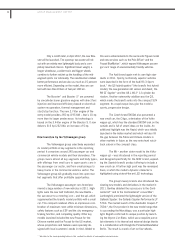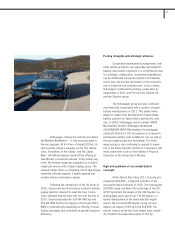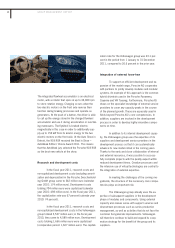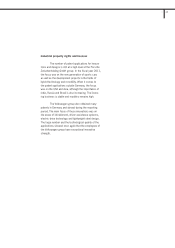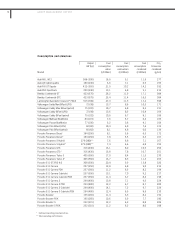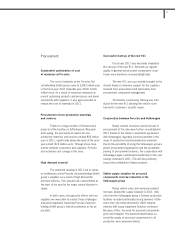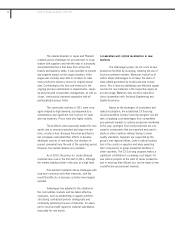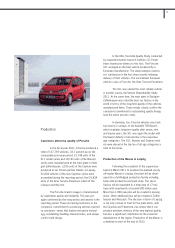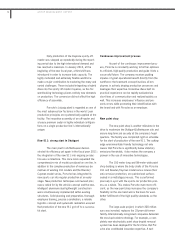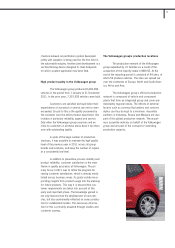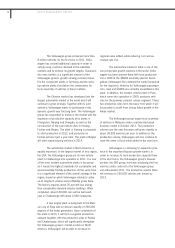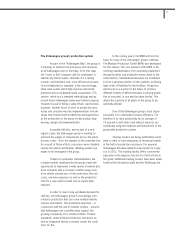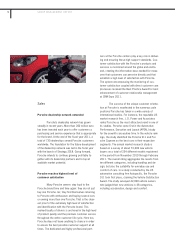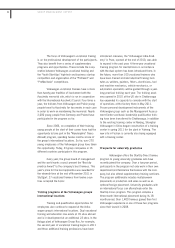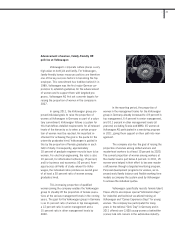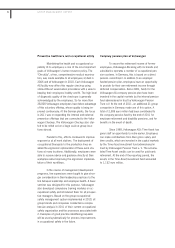Porsche 2011 Annual Report Download - page 76
Download and view the complete annual report
Please find page 76 of the 2011 Porsche annual report below. You can navigate through the pages in the report by either clicking on the pages listed below, or by using the keyword search tool below to find specific information within the annual report.
The Volkswagen group produced more than
8 million vehicles for the first time in 2011. Volks-
wagen has created additional capacity in order to
satisfy rising customer demand in the individual
markets and to achieve its growth targets. Expansion
into new markets is a significant element of the
Volkswagen group's growth strategy and also bene-
fits the component plants in Germany and the exist-
ing vehicle plants that deliver the components for
local assembly of vehicles in these markets.
The Chinese market has developed into the
largest automobile market in the world and it will
continue to grow strongly. Together with its joint
ventures, Volkswagen wants to participate in this
dynamic growth over the long term. The Volkswagen
group has responded to trends in the market with the
expansion of production capacity at its plants in
Changchun, Nanjing and Chengdu, as well as the
construction of the new vehicle sites in Yizheng,
Foshan and Ningbo. The plant in Yizheng is projected
to start production in 2012, and production in
Foshan will start just a year later. The plant in Ningbo
will start manufacturing vehicles in 2014.
The automobile market in North America is
equally important. In the largest market of this region,
the USA, the Volkswagen group put its new vehicle
plant in Chattanooga into operation in 2011. It is one
of the most modern automotive plants in the group
as it meets the highest standards for sustainable and
environmentally friendly production. At the same time
it is a significant element of the overall strategy in the
region, based on which Volkswagen intends to achie-
ve its long-term volume and profitability goals there.
The factory requires about 35 percent less energy
than comparable standard industry buildings. When
completed, about 150,000 cars will be built each
year in Chattanooga with about 2,500 employees.
A new engine plant is being built in the Mexi-
can city of Silao with an annual capacity of 330,000
engines of the latest generation. Upon completion of
the plant in 2013, it will form a regional production
network together with the production sites in Puebla
and Chattanooga, which will significantly strengthen
the Volkswagen group's market position in North
America. Volkswagen will be able to increase its
regional value added, while reducing cost and ex-
change rate risk.
The automotive market in India is one of the
most important growth markets in the world. Volks-
wagen has been present there with local production
since 1999 at the ŠKODA assembly plant in Auran-
gabad; Volkswagen thus entered the market prepared
for the long-term. Vehicles for Volkswagen passenger
cars, Audi and ŠKODA are currently assembled in this
plant. In addition, the modern vehicle plant in Pune,
which came into operation in 2009, produces vehi-
cles for the growing compact saloon segment. These
two production sites form the basis from which it will
be possible to profit from strong future growth in the
Indian market.
The Volkswagen group began local assembly
of vehicles in Malaysia under a partnership-based
business model in October 2011. The production
volume over the next few years will grow steadily to
about 30,000 vehicles per year. In addition to the
production volume, Volkswagen will also continue to
raise the share of local value added in the near term.
Volkswagen is continuing to expand its pres-
ence in the important Russian growth market. In
order to increase its local production capacity there
in the short term, the Volkswagen group's Russian
partner, the GAZ group, has been producing the first
vehicles under contract to the Volkswagen group
since November 2011. The production volume there
will increase to 100,000 vehicles per annum by
2013.
GROUP MANAGEMENT REPORT76


